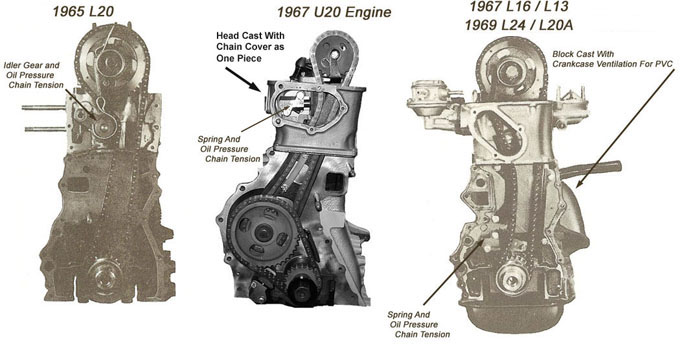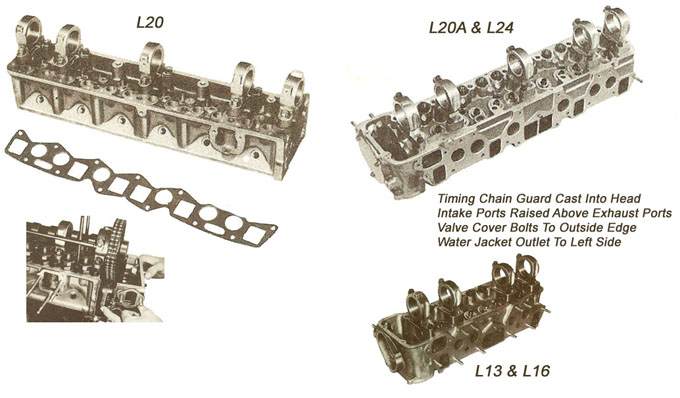In the late 50's and early 60's Japan's fledging automotive industry was making the Post War transition from producing automobiles and power-plants designed by and purchased or licensed from foreign sources, toward the ability to design, develop and produce their own.
Nissan's Design Division consisted of about 59 people in 1959. At that time the Engine Design team was producing 1 liter, 4 cylinder push rod type engines, of a modified Austin design.
By Jan. of 1965 Mr. Hara's Design Dept. having grown too large underwent a significant reorganization. Vehicle Design {Styling} and Automotive Engineering were split into two different divisions. Within Automotive Engineering, Engine Design was farther divided into two groups. Mr. Iida was assigned to the Second Engine Design Division, where large engines were designed. {for Cedric and larger Trucks}. The First Engine Design Division was in charge of the small displacement engines, installed on the Bluebird and others.
So we start our summary of Nissan Engine Design & Development with Mr. Iida and Nissan's first 2.0 liter, OHC, in-line six cylinder engine.
Oct. 1965 - Nissan L20
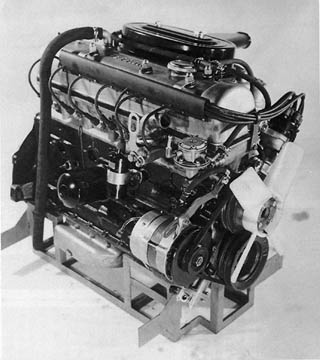

Nissan's first over head cam, L Type, in-line six cylinder engine was designated the L20 and was introduced in Oct. of 1965 in the 1966 Model Cedric H130 Series (Mark 1), Special Six, which went on sale in early 1966.
In 2004, Mr. Kumano Manabu interviewed the man placed in charge of the design of the L20 and then wrote an article for Nostalgic Hero Magazine. Mr. Manabu reports that in April of 1964, Mr. Hiroshi Iida was assigned to the Second Engine Design Division, of the Design Organization at Nissan. The Second Engine Design Division was responsible for the design of larger displacement engines installed in the Cedric and others, as well as the large displacement engines used in trucks. The First Engine Design Division was responsible for the smaller displacement engines installed in the Bluebird (Datsun 411 and 510) and others.
Mr. Iida reported that the design effort took place on a very rushed schedule, lasting only four months from start to the production of test engines in Oct. of 64. The design cycle was rushed because Nissan wanted to keep abreast of its competition from Toyota.
Mr. Iida tells us this rapid design was accomplished by taking the drawings of the block, from a previously designed L Type 4 Cylinder Engine and adding two cylinders to it. Mr. Iida said that they used the Mercedes Benz OHC design, wherein 12 valves are driven by a single over head cam shaft via adjustable rocker arms. The Cam is driven by a double row, roller chain with power taken off the crankshaft.
During the engine development phase, where pre-production engines are built and tested; problems with the oil pump and distributor drive mechanism were identified and corrected. Problems related to the cam towers cracking were also identified and corrected.
It was later found that the production engines suffered from excessive oil consumption caused by problems with the design of the oil rings and the valve seals. Customers also complained about excessive noise, and poor fuel economy, brought about by the need to maintain the engine at high idle speeds. After the first year of production, several of these problems were at least mitigated in a second production run. The engine originally equipped with twin side draft type carb.'s - was then equipped with a single down-draft carb., and HP reduced from 123 to 112.
Because of its rushed design and development cycle, and the resulting problems that plagued it the L20 would be short lived in the Nissan line-up.
1967 - Nissan/Datsun U20

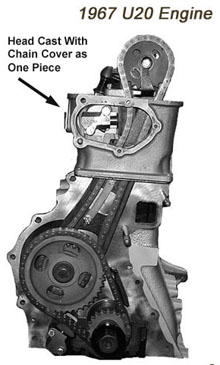
With the merger of the Prince Motor Company into Nissan started in 1965 and finalized in the beginning of 1966, engineers from Prince were also working on a 2.0L engine for Nissan. They designed a new over-head cam cylinder-head to be mounted on Nissan's existing "R" series over head valve engine. The new cylinder head design incorporated an overhead cam, larger valves and better flowing intake and exhaust ports. The new engine designated the U20 was first offered in the Datsun 2000 roadster for 1967 and continued into the 1970 model year.
The U20 was available as either a 135HP version with twin S.U. style, single throat, side draft carb's, or a 150HP version running twin Solex type, dual throat, side drafts. The 4 cylinder 2.0 liter U20 produced significantly more HP than the previous L20 in a smaller and far lighter package.
1967 - L16
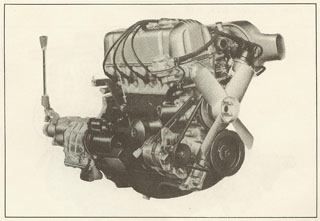

The Datsun PL510 aka the Bluebird in Japan, was being developed in 1965/1966 as the replacement for the Datsun 411 sedan. While the original plans called for the use of Nissan's existing pushrod 4 cylinder engine: Mr. Yutaka Katayama , President of Nissan Motors in USA, lobbied the home offices for the new 1600cc overhead cam , in-line 4 cylinder engine, already in development, for his American market Datsuns. The previous smaller displacement, overhead valve engines, in the Datsun 411 Sedans sent to America had a hard time keeping pace with traffic on the Freeways around Nissan's L.A. Corporate offices, and this lack of performance hurt Datsun sales across the U.S.
Feeling that his request was not being given the support necessary at the home offices in Japan; Mr. Katayama took his request directly to one member of Nissan Motors Board Of Directors. Mr. Matsumura listened to Mr. K's request and rational for it; then in April of 1966 sent a letter directing the production and use of a new 1600cc, overhead cam, four cylinder for the PL510, the L16. (Halberstan's "The Reckoning")
The result was the introduction of the completely new OHC L16, and a de-stroked version the L13 for the domestic market (1595cc and 1296cc) in 1967. This engine was an over-square design with an 83mm bore and 73mm stroke. (59.9mm stroke for the L13). The L16 was rated at 96 hp at 8.5:1 compression and 109 hp at 9.5:1 compression. (77hp for the L13 at 8.5:1 compression).
Unlike the original L20, Mr. Iida tells us that the L16 was given a full design and development cycle in the Small Engine Design Division. The result was a superior design that proved itself over the following years and which would serve as the basis for the creation of the the L24 and the new L20A that followed for the 1970 Model Year.
Because the cylinder head design was very similar to the previous U20, many people see the roots of the design of the L16's head in the U20.
The L16 was to form the basis for Nissan's "Modular L Series" engine line-up well into the 1980's. Mr. Iida tell us that engines that share a common design and also share common parts are referred to as modular engines. This keeps the design and manufacturing costs down, as well as lowering the costs associated with technician training and replacement parts inventories, necessary for customer support after the sale.
1968 -S20
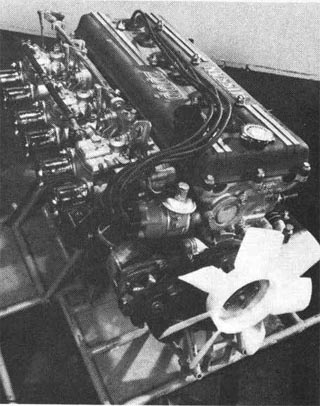
In Feb. of 1968 the Skyline 2000 GT-R is introduced by Nissan. The PGC-10 (P for Prince) sports the S20, twin overhead cam with triple side draft solex type carb's. Rated at 160 HP the S20 is derived from Prince's racing program. Mr. Matsuo tells us that in Aug. of 1967 his management directed the use of the S20 from the newly merged Prince Motors in the Z Car, in addition to the L24 requested by Mr. Katayama for America. This management decision incidentally created the Fairlady Z-432.
1968- L23
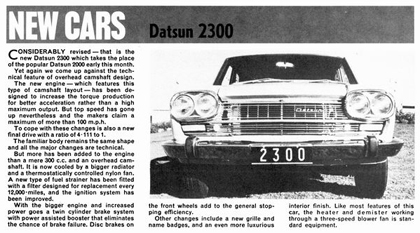
In Sept. of 1968 Nissan introduced the L23 (2262 cc) and was first offered in the 1968 Nissan Cedric Special/Super Six (DATSUN 2300). This engine was of the same design as the earlier L20. Using an 83mm bore and 67.9mm stroke, it produced 123hp at 9.0:1 compression, with a single downdraft carb. Produced in very limited numbers it was replaced the following year by the new L24.
1969 - L24

The L24 (2393cc) was introduced in 1969 for the Cedric. The same design as the earlier L16, with an 83mm bore and 73.7mm stroke with two additional cylinders. The L24 would be the engine requiested by Mr. K for use in upcoming Datsun 240Z
1970 - L20A
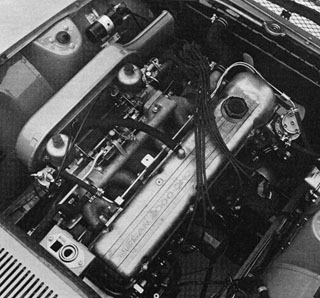
According to Mr. Iida, the design improvements found in the newer and more fully developed design of the L16, were too good to pass up, so L20A OHC, in-line six was designed to take advantage of them. The new 2.0 liter, OHC, in-line six based on the design of the L16 was designated the L20A.
The design cycle of the L20A was completed in Jan. of 1968, followed by the usual production prototypes, testing and then full production starting at the end of 1968. The L20A was introduced in Oct. 1969 for the 1970 Model Year. Introduced in the Nissan Fairlady Z, as well as in the new Cedric.
The L20A was an over-square design with 78mm bore and 69.7mm stroke, producing 125hp at 9.0:1 compression with twin side draft carb.'s.
Notes/Thoughts:
A high performance engine from Prince Motors, the S20 was featured in the Prince Skyline GT-R and the Nissan Fairlady Z 432. The S20 featured four valves per cylinder, three side draft carbs and two overhead cam's. This 1988cc six cylinder was also an over-square design with 82mm bore and 62.8mm stroke. It was rated at 160hp at 9.5:1 compression.
While the S20 provided a 2.0 liter, six cylinder engine with serious performance for the Japanese Domestic Market at a time when engines with more than 2.0 liter displacement were heavily taxed, it was at the same time mechanically complex and expensive to produce. The result was the limited production of the Fairlady Z 432 at a cost of 1.6 to 1.8 Million Yen {about $4500.00 to $5100.00 USD}.
With the L20A completing its design cycle in Jan. of 1968 and entering production by the end of that year, it would offer a less expensive 2.0 liter alternative to the S20 for use in the Fairlady Z. At 976,000 Yen {$2711.00 USD} the Fairlady Z was available to a far greater number of people in terms of both initial purchase price and operational costs in Japan.
Then with the relaxation of the punitive taxes on engines over 2.0 liter displacement at the end of 1971, use of the L24 became an optional performance enhancement resulting in the release of the Fairlady 240Z for the JDM in Oct. of 1971. The L24 producing close to the same HP as the S20 in stock form, with far less mechanical complexity was sold in far greater numbers than the limited production Z 432. Aprox. 4200 Fairlady 240Z's were sold in Japan during the 72 and 73 Model Years. The Fairlady 240Z equipped with triple side draft solex type carb.'s and high performance exhaust system the L24 was rated at 175 HP and replaced the Z432-R as Nissan's domestic competition car.
